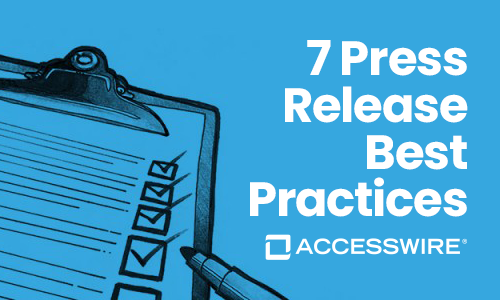How to Write a Merger or Acquisition Press Release
There are few times in business that are more nerve-wracking than the months and weeks leading up to an official announcement of a merger with, and/or acquisition of, another business. Striking such a deal isn’t easy for any of the principals involved: There’s excitement, sleepless nights, long workdays, fear, back-to-back meetings and phone calls, stress, and more.
Of all the public relations ingredients that go into sharing your merger or acquisition news, one thing is certain...
There’s no room for error when it comes to your M&A announcement and press release.
Read on to learn how to make your Announcement Day a public relations success.
Getting Started with the Process
When two companies agree in principle to either buy, merge with, or sell to, another organization, the real work begins…and boy, is there a LOT of work, especially for your Investor Relations team (if your company is public), as well as your public relations and marketing professionals. Sure, your legal teams will be busy as well, but the importance of what eventually becomes Announcement Day cannot be overstated.
Your company will have only one chance to position the M&A announcement as an exciting, positive event for all your audiences. Anything less than that has the potential to spell disaster for your business.
Mergers and acquisitions can affect lives, and livelihoods. Think about all the ripple effects that can occur with your news: The market reaction, if at least one of the companies is public, can either help or hurt your company’s value for better or worse; if your company is privately held, your stakeholders will be affected, whether they are your business’s investors, suppliers, customers, or employees.
Speaking of employees, many M&As involve having to make hard decisions about who will be part of the new team going forward, and who might not make the cut.
There is such a bigger picture behind any merger or acquisition, sometimes it’s hard to take in all that must be handled between the tentative agreement and the close of the deal. Everything about your announcement presentation will be scrutinized by your shareholders/stakeholders, media outlets and journalists that cover your company’s industry, employees, and customers.
To put it in the bluntest of terms, there will be questions from all sides. Your most important job, as a corporate communicator, is to make sure there is an answer for every question asked.
Who Knows What?
The tricky part to making sure you know all the answers to every question is that you might not be privy to all of the information. Generally, there is an exceedingly small group of people who will know the full story behind whatever deal has been tentatively reached. The C-Level and legal teams will, obviously, know everything that the agreement entails.
Discretion is of the utmost importance when two companies become one, but if you are part of the communications team that will craft some or all of the messaging in advance, you will be trusted with some incredibly complex and confidential information.
Letting the cat out of the bag in any way could completely destroy the merger or acquisition itself. Additionally, if either company is publicly traded, talking or writing (email or text) about what your company is involved in can easily break some Securities and Exchange Commission rules and/or laws.
No matter how much you want to share your company’s exciting and important news before Announcement Day, we offer one word of advice... Don’t.
Understanding the M&A Announcement and Press Release
According to Harvard Business Review, there are three functions that Announcement Day covers.
First, if the communications during diligence are as thorough and organized as possible, the findings can “serve as a litmus test of the deal logic for acquirer executives – where they think like an investor – well before Announcement Day itself.” In other words, the research and reporting shared between the two companies can stand as a testament that the deal will be a beneficial one, which in turn gives your audiences confidence.
Second, all of the communications you will be putting together and distributing, i.e., investor presentations, conference calls, and press releases, will allow both companies’ stakeholders or shareholders to review the deal from all angles and independently evaluate the deal.
Third, the announcement itself allows the company leaders to set the tone, and perhaps the expectations too, to all target audiences – employees in particular. The words that the company leaders use have incredible power and can influence the entire culture of the company that exists after the deal goes through.
Now that you have a deeper understanding of what is at stake with regard to your company’s merger or acquisition, it’s time to write the all-important press release!
Steps for Building a Merger or Acquisition Press Release
A general press release uses many of the same features that your M&A announcement will contain. There are specific boxes you’ll need to check, however, that will set your Merger or Acquisition Press Release apart.
Keep in mind that both company leaders should be featured in your merger or acquisition announcement, and their messages, while separate, should contain verbiage that injects excitement and pride into the message. Let’s go step-by-step and follow a tried-and-true M&A release that will get your news noticed.
1. Make your headline memorable.
Remember, this kind of announcement is BIG news, not only for your company’s shareholders or stakeholders, but also for another organization’s key audiences, as well.
Try to include any aspects of the deal worth highlighting in the headline. Will revenues increase? Will the new unified company have a bigger presence within the industry? Anything that shines a “wow” spotlight on the deal should be mentioned.
2. Make your headline memorable. Provide details about the new company.
The first paragraphs should provide an overview of the deal…the “who,” “what,” “when,” “where” and “how” of the deal should be included.
3. Explain the reason behind the deal.
Your target audiences will want to know why the two companies decided to become one. Were there similar synergies that were beneficial? Will the post-deal company increase market share? Let people know why the leaders of both companies are smart to enter into this union.
Other details you should cover in the reasons the deal was reached include:
- Any name changes to the newly formed entity
- The impact that the merger or acquisition will have on the industry, shareholders, customers, and/or public
- Information about any new products and/or services that will be offered as a result of the deal
- The new company’s mission, and any operational changes that will take effect
- Who the owner and/or CEO will be
4. Quotes from the leadership.
There are sometimes occasions when there will be only one spokesperson to comment on the merger or acquisition, but ideally, decision-makers from both companies should deliver a satisfied, hopeful message that lets shareholders and/or stakeholders on both sides know that the merger/acquisition is a great thing. Titles for such spokespeople include CEOs, Presidents, Chairman of the Board, or other C-Level people.
5. Include imagery in the press release.
If the merger or acquisition has been made with changes to the overseeing company’s logo, be sure to include that, and use the new version, going forward. Images of the CEO(s), Board Chair, or key investors are also good to include. [As an aside, ACCESSWIRE allows logos, photos, and even embedded videos at no extra cost in all press release distributions; see below for details.
6. Include the new company’s website URL.
You should mention it in the release itself, as well as in the boilerplate.
7. And speaking of the boilerplate...
Chances are likely that the lead company will want to update the boilerplate information for the bottom of every press release; the company merging into the other, or being acquired, should also include its boilerplate paragraph.
8. Provide contact information at the end.
Providing contact names/email addresses/phone numbers for both companies is not unusual nor frowned upon, but in lieu of contacts for both companies, contact information for someone with the lead company will suffice.
Summary
No matter how you slice it, the announcement of a merger or acquisition is a significant change for both companies involved in the deal, and the process is a long exercise in precise, deliberate composition.
What you say will have a great impact that can either lead to positive attention to your new company or can leave your audience with more questions than answers. Being thorough is critical, and as said before, there is no room for error at any stage.
You should choose a press release distributor who can help your communications team along the way, and a customer service desk that is available to you 24/7/365. At ACCESSWIRE, you will receive all the help and positive attention you need to make sure your important Announcement Day goes off without a hitch. If you would like a complimentary demo of the ACCESSWIRE platform, simply click here, fill out the form, and let one of our knowledgeable representatives show you our user-friendly interface.
Similar Blog Posts
PRODUCTS
ACCESSWIRE | All Rights Reserved




